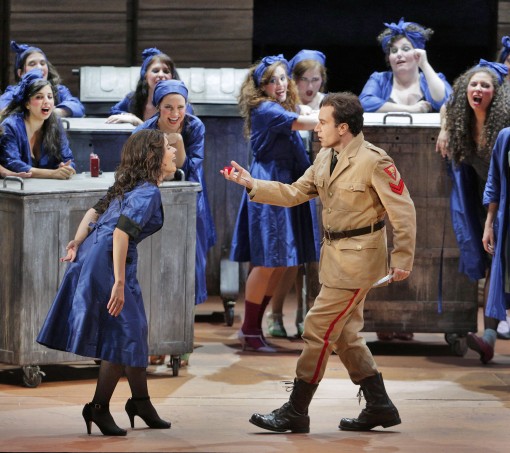The personal is political in Santa Fe’s incendiary border-crisis “Carmen”
Santa Fe Opera’s new production of Carmen is the third staging I have seen this year alone. An opera that is mounted this often invariably receives a lot of mediocre performances, but when a director does something new with his staging, and when there is a major vocal discovery to be made, there’s always room for another torrid night of Bizet’s tale of tragic Spanish love.
In a summer of operas updated to the mid-20th century, director Stephen Lawless places the action of this Carmen in Mexico in the 1960s, with the band of criminals in Act III smuggling people across the U.S. border. The period elicits some outrageous and colorful costumes (designed by Jorge Jara), with the inn of Lillas Pastia transformed into a seedy disco-ball nightclub, headlined by the big-haired trio of Carmen, Frasquita, and Mercédès, and Pastia himself played as a two-bit pimp and cocaine dealer by Grant Neale.
It may seem that the title role is the one to worry about in this opera, but it is not really that hard to find an effective Carmen. The opera hinges in many ways on the more complicated role of Don José, requiring a tenor with serious vocal goods who can make the dramatic arc from country simpleton, the only soldier in the regiment who does not even notice Carmen, to jealous murderer.
Italian tenor Roberto De Biasio made an astounding company debut in the role, with a savant marshaling of impressive vocal force, keeping his ringing top in strong form until the bitter end. His French pronunciation may need a little work, but De Biasio gave exquisite phrasing to every line and had all the qualities of a voice to remember, including spot-on intonation, a floating pianissimo, and faultless blend in ensemble work. His Don José was a hopeless do-gooder, at one point refusing to share a stiff drink with his lieutenant and blissfully lost in his clerical work at a corner desk while the cigarette girls displayed their wares. He never lost the fussy reticence of a young man under the thumb of a devout mother, which helped explain why he was always so physically uncomfortable with both the women in his life. Naturally, he shows up to murder Carmen in the fourth act while wearing a three-piece suit.
Ana María Martínez was a sexy and vitriolic Carmen, more spiteful virago than tempting seductress, although not embarrassing herself while dancing, which is a plus. Her viscous tone, bountiful in the mid-range, mostly suited the role, the usual complaints about a soprano singing a mezzo-soprano part aside. She wanted to make every line of her solos significant and full of individuality, so she tended to drag things out too much, in which she was indulged by British conductor Rory Macdonald, in an uneven company debut, although the orchestra produced excellent sounds overall. In a running gag in this updated staging, Martínez sang some of her arias to the “accompaniment” of a transistor radio, which relieved her of having to pretend to play the castanets.
Kostas Smoriginas’s bass-baritone was imperious at the top, where it needs to be for Escamillo, and he had fun with the staging’s pitiless deflation of the character’s ego, entering in Act II on a mechanical bull, drunk and in a ridiculous costume with leather fringe — part matador, part Elvis impersonator.
Soprano Joyce El-Khoury was a disappointment as Micaëla, her intonation too often off-target, her breath support flagging, and with a tendency to scoop up to notes, spoiling most of the character’s celestial music, the most beautiful in the opera. Among the supporting cast, mostly apprentice singers, bass-baritone Evan Hughes had another distinguished turn, as Lieutenant Zuniga.
The blandness of the set panels that fill the stage, a nondescript gray that looks like clapboard or corrugated metal (set design by Benoit Dugardyn), is offset by their use as screens for projections designed by Jon Driscoll. These include grainy footage of bullfights, as well as offstage events like the death of Don José’s mother and the activities of the smugglers, original footage shot with the cast members. The most effective moment for the projections was the appearance of Don José’s mother, sternly hovering on the screen during the Act I scene between Don José and Micaëla.
Lawless is a little heavy-handed with the opera’s more symbolic moments, especially the equation of the bull skewered in the arena with Don José’s battle with Carmen. A dumb show at the moment when Bizet’s fate theme is first heard has Carmen pretend to be stabbed in the back while Don José is opening envelopes with a letter opener, and at the end of the opera, Don José uses his coat like a toreador’s cape to taunt Carmen and to hide the fatal knife. These scenes made clumsily explicit what was left artfully implicit in the libretto.
Carmen continues through August 23 at Santa Fe Opera. santafeopera.org.
Charles T. Downey is a freelance writer on music and roving summer festival reporter. The rest of the year he lives in Washington, D.C., where he writes reviews for the Washington Post and moderates ionarts.org, a Web site on classical music and the arts.
